Abstract
OBJECTIVE: Lactate dehydrogenase (LDH), a tetrameric protein composed of four monomers, is expressed as five isoenzymes. Serum LDH isoenzymes may be useful in differential diagnosis of ascites etiology since tissue damage releases isoenzymes contained therein, leading to a change in their pattern. MATERIALS AND METHODS: We determined ascitic fluid LDH level and LDH isoenzyme activities in patients with malignant and nonmalignant ascites in a total of 76 patients (43 males and 33 females). RESULTS: LDH level, LDH-4 activity and LDH-5 activity were found to be significantly higher, and LDH-1 activity was found to be lower in malignant ascites when compared with nonmalignant ascites. LDH-1 activity was detected to be significantly higher in the sterile cirrhotic ascites when compared with spontaneous bacterial peritonitis, malignant ascites, tuberculous ascites and congestive heart failure-related ascites. LDH-2 activity was found to be higher in spontaneous bacterial peritonitis when compared with the other groups. LDH-3 activity was detected to be higher in spontaneous bacterial peritonitis, malignant ascites and tuberculous ascites when compared with the sterile cirrhotic ascites. In the diagnosis of malignant ascites, the sensitivity and specificity were 96% and 76% for LDH level, 90% and 70% for LDH-1 activity, 94% and 62% for LDH-4 activity, and 100% and 56% for LDH-5 activity, respectively. CONCLUSION: Ascitic LDH and its isoenzyme pattern may be helpful for the differential diagnosis of the most common causes of ascites: cirrhosis, spontaneous bacterial peritonitis, congestive heart failure, tuberculosis and malignancy.
Full text
PDF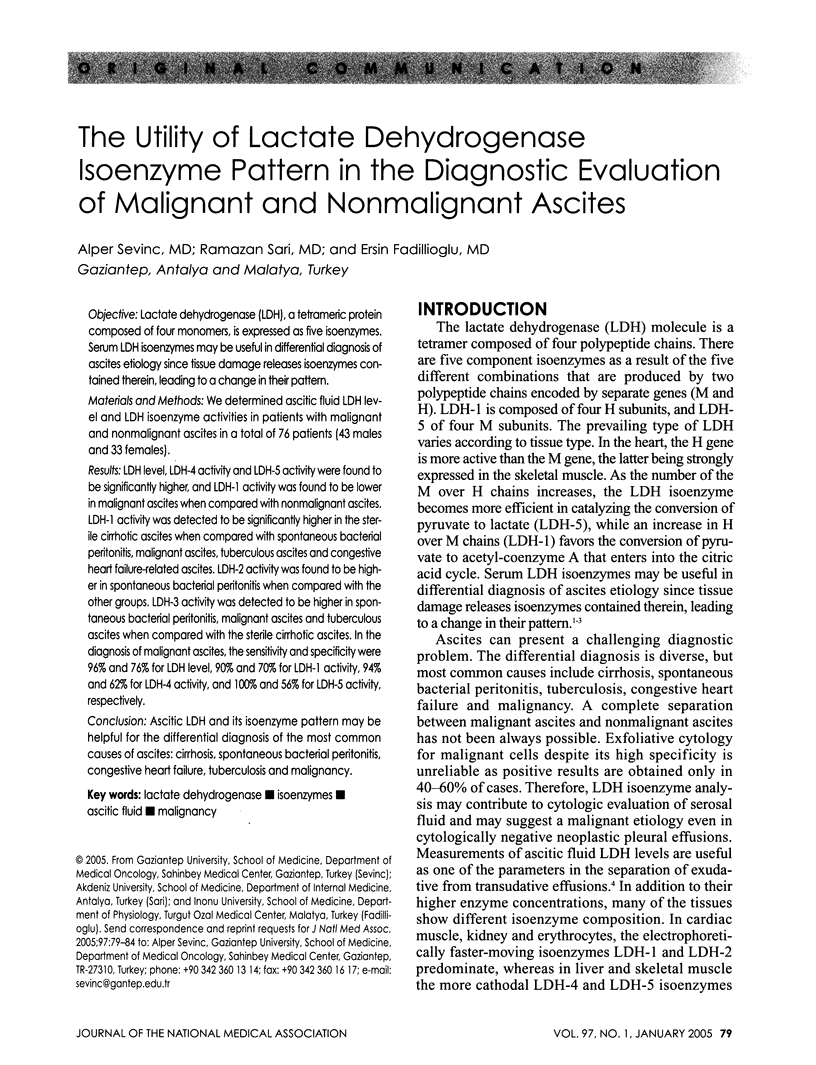
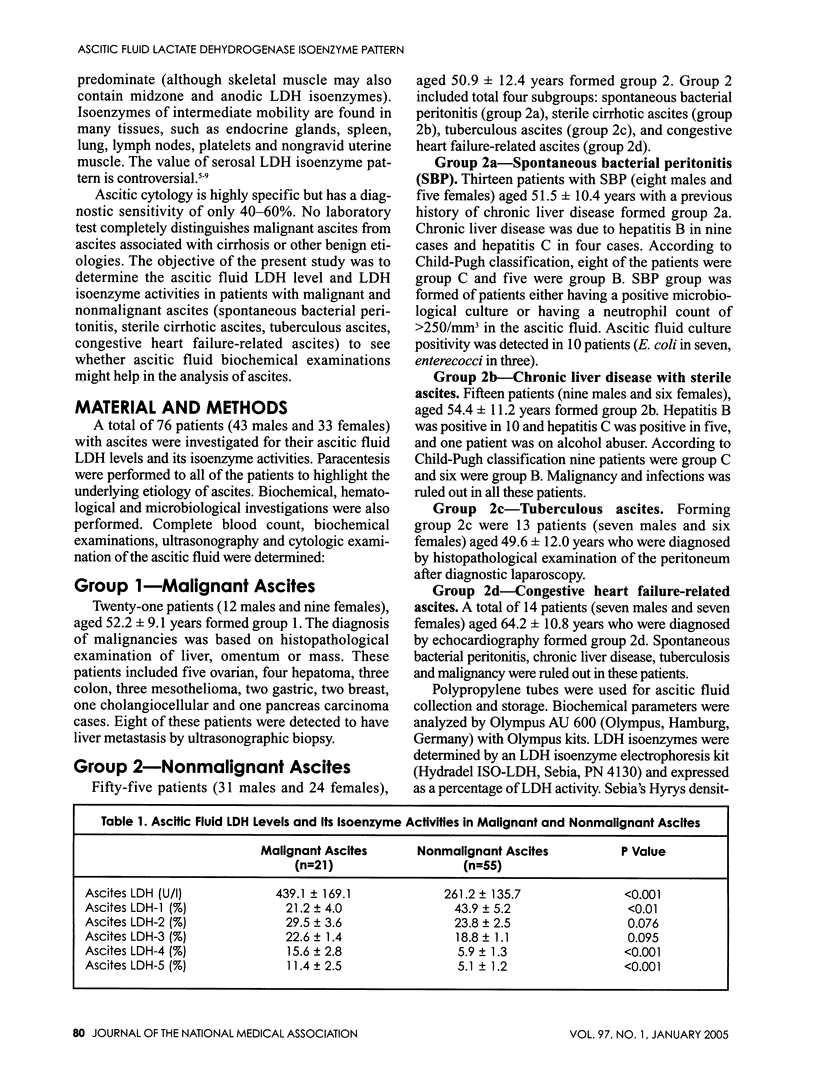

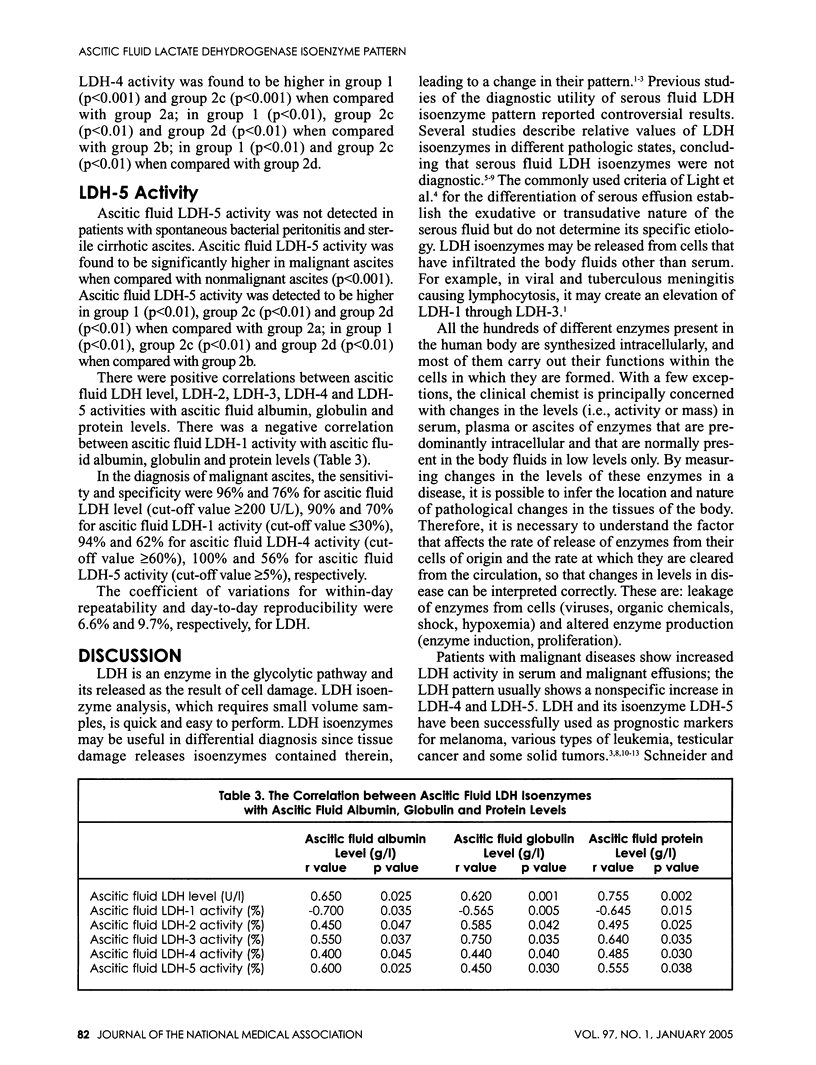
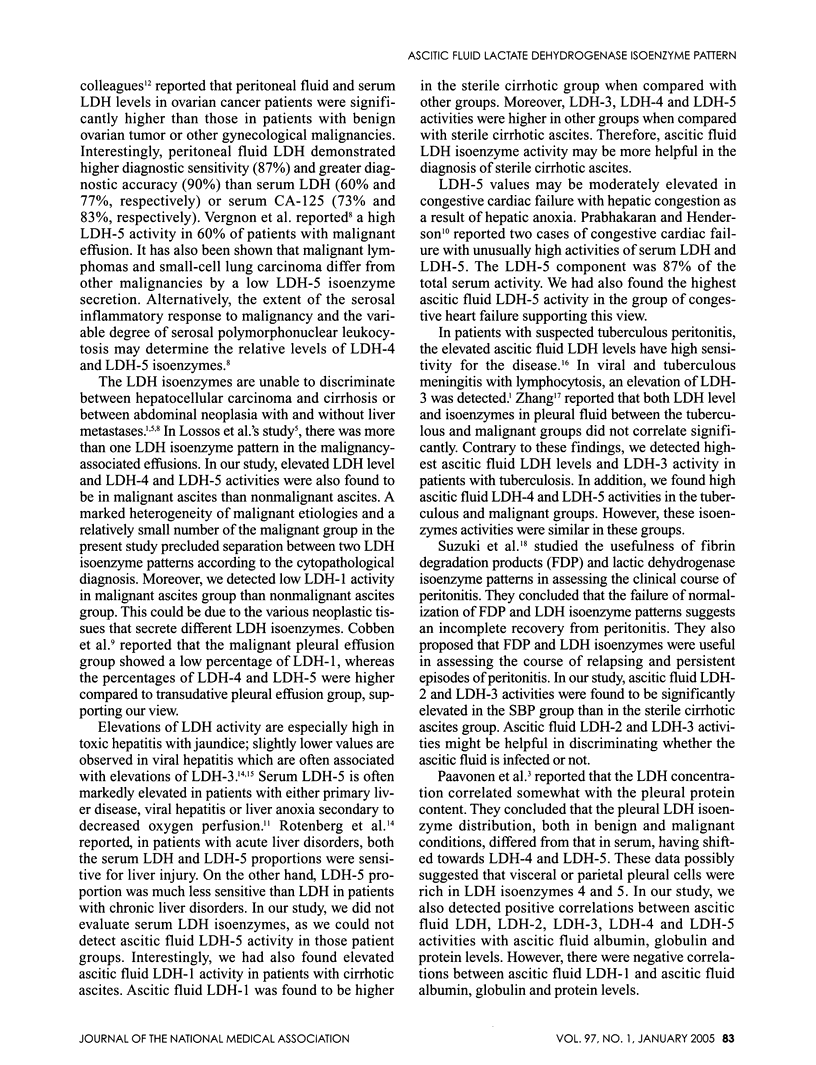
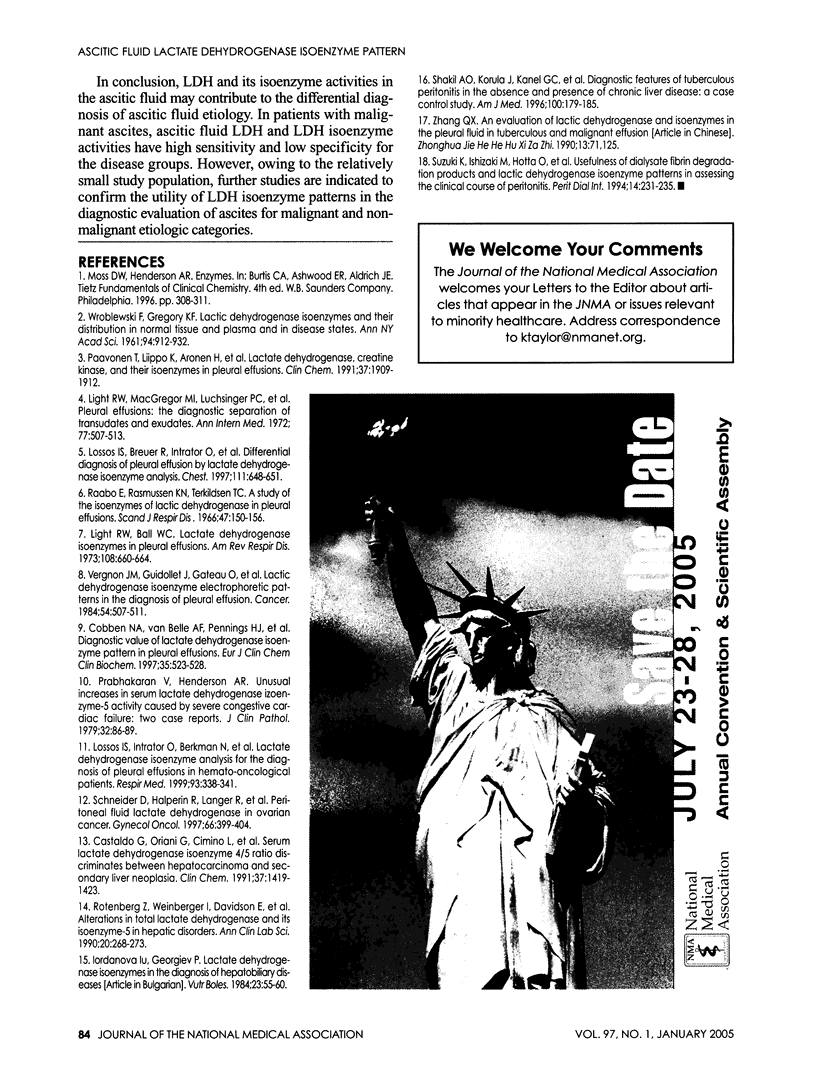
Selected References
These references are in PubMed. This may not be the complete list of references from this article.
- Castaldo G., Oriani G., Cimino L., Topa M., Budillon G., Salvatore F., Sacchetti L. Serum lactate dehydrogenase isoenzyme 4/5 ratio discriminates between hepatocarcinoma and secondary liver neoplasia. Clin Chem. 1991 Aug;37(8):1419–1423. [PubMed] [Google Scholar]
- Cobben N. A., van Belle A. F., Pennings H. J., Mulder P. G., van Dieijen-Visser M. P., Wouters E. F., Drent M. Diagnostic value of lactate dehydrogenase isoenzyme pattern in pleural effusions. Eur J Clin Chem Clin Biochem. 1997 Jul;35(7):523–528. doi: 10.1515/cclm.1997.35.7.523. [DOI] [PubMed] [Google Scholar]
- Iordanova Iu, Georgiev P. Izoenzimite na laktatdekhidrogenazata v diagnostikata na chernodrobnozhlŭchnite zaboliavaniia. Vutr Boles. 1984;23(6):55–60. [PubMed] [Google Scholar]
- Light R. W., Macgregor M. I., Luchsinger P. C., Ball W. C., Jr Pleural effusions: the diagnostic separation of transudates and exudates. Ann Intern Med. 1972 Oct;77(4):507–513. doi: 10.7326/0003-4819-77-4-507. [DOI] [PubMed] [Google Scholar]
- Lossos I. S., Breuer R., Intrator O., Sonenblick M. Differential diagnosis of pleural effusion by lactate dehydrogenase isoenzyme analysis. Chest. 1997 Mar;111(3):648–651. doi: 10.1378/chest.111.3.648. [DOI] [PubMed] [Google Scholar]
- Lossos I. S., Intrator O., Berkman N., Breuer R. Lactate dehydrogenase isoenzyme analysis for the diagnosis of pleural effusion in haemato-oncological patients. Respir Med. 1999 May;93(5):338–341. doi: 10.1016/s0954-6111(99)90315-3. [DOI] [PubMed] [Google Scholar]
- Paavonen T., Liippo K., Aronen H., Kiistala U. Lactate dehydrogenase, creatine kinase, and their isoenzymes in pleural effusions. Clin Chem. 1991 Nov;37(11):1909–1912. [PubMed] [Google Scholar]
- Raabo E., Rasmussen K. N., Terkilesen T. C. A study of the isoenzymes of lactic dehydrogenase in pleural effusions. Scand J Respir Dis. 1966;47(2):150–156. [PubMed] [Google Scholar]
- Rotenberg Z., Weinberger I., Davidson E., Fuchs J., Harell D., Agmon J. Alterations in total lactate dehydrogenase and its isoenzyme-5 in hepatic disorders. Ann Clin Lab Sci. 1990 Jul-Aug;20(4):268–273. [PubMed] [Google Scholar]
- Schneider D., Halperin R., Langer R., Bukovsky I., Herman A. Peritoneal fluid lactate dehydrogenase in ovarian cancer. Gynecol Oncol. 1997 Sep;66(3):399–404. doi: 10.1006/gyno.1997.4792. [DOI] [PubMed] [Google Scholar]
- Suzuki K., Ishizaki M., Hotta O., Horigome I., Sudo K., Kurosawa K., Taguma Y. Usefulness of dialysate fibrin degradation products and lactic dehydrogenase isoenzyme patterns in assessing the clinical course of peritonitis. Perit Dial Int. 1994;14(3):231–235. [PubMed] [Google Scholar]
- The future role of subspecialists in departments of internal medicine. Am J Med. 1996 Jan;100(1):1–7. doi: 10.1016/s0002-9343(96)90001-7. [DOI] [PubMed] [Google Scholar]
- Vergnon J. M., Guidollet J., Gateau O., Ripoll J. P., Collet P., Louisot P., Brune J. Lactic dehydrogenase isoenzyme electrophoretic patterns in the diagnosis of pleural effusion. Cancer. 1984 Aug 1;54(3):507–511. doi: 10.1002/1097-0142(19840801)54:3<507::aid-cncr2820540320>3.0.co;2-4. [DOI] [PubMed] [Google Scholar]
- WROBLEWSKI F., GREGORY K. F. Lactic dehydrogenase isozymes and their distribution in normal tissues and plasma and in disease states. Ann N Y Acad Sci. 1961 Nov 2;94:912–932. doi: 10.1111/j.1749-6632.1961.tb35584.x. [DOI] [PubMed] [Google Scholar]
- Zhang Q. X. [An evaluation of lactic dehydrogenase and isoenzymes in the pleural fluid in tuberculous and malignant effusion]. Zhonghua Jie He He Hu Xi Za Zhi. 1990 Apr;13(2):71–125. [PubMed] [Google Scholar]


